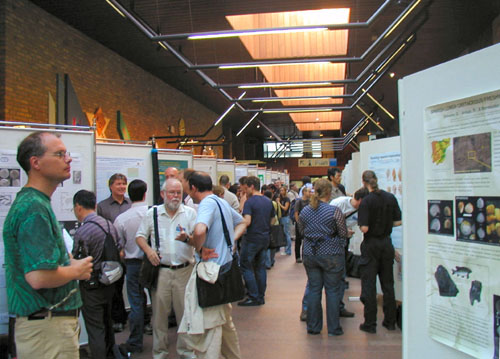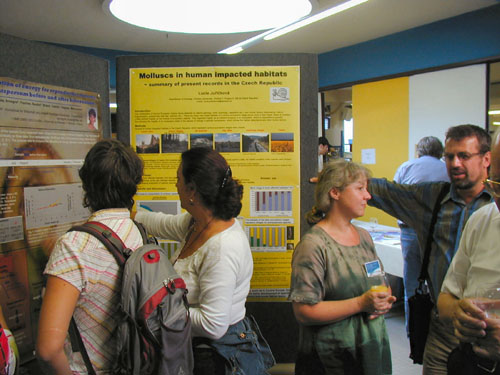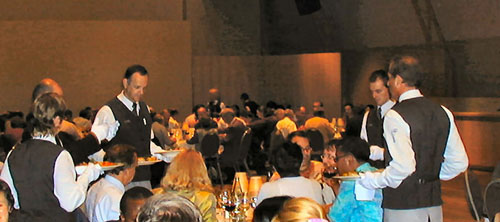

|
The 16th
triennial Congress of Unitas Malacologica together with the
American Malacological Society’s annual meeting combined
as the WCM at the University of Antwerp. The congress attracted
421 delegates from 45 nations, including 75 from USA. Delegates
included 146 students and 204 Unitas members. Programme. There were four parallel sessions in adjacent theatres, on Monday, Tuesday, Thursday and Friday. The major themes each covered by more than 20 papers were: · Molluscs as models in evolutionary biology: from local speciation to global radiation · Inventorying the molluscan fauna of the world: frontiers and perspectives · Sexual selection in molluscs · Micromolluscs: methodological challenges, exciting results · Neogastropod origins, phylogeny, evolutionary pathways and mechanisms. The two most novel and refreshing themes here are probably sexual selection - which Darwin claimed could not occur in hermaphrodite and sensually challenged molluscs - and micromolluscs—the majority of species, but seriously underworked. There were also sessions on Terrestrial molluscs, Ecotoxicology, Quaternary malacology, Molluscan models: the eye, Molecular phylogeny and evolution, Freshwater bivalves – extinctions and invasions , Marine ecology, Pest control, Zoogeography of non-marine mollusks of the eastern Mediterranean,Bivalve molecular phylogeny, Bivalve taxonomy, Molluscan hearts and circulation, Opisthobranch systematics and phylogeny, Deep sea molluscs, Freshwater molluscs, and General taxonomy and phylogeny. Amongst these latter themes, the molluscan eyes sessions made a bold attempt to develop a molluscan model alongside other recent invertebrate eye models from Drosophila, Platynereis and Tripedalia, with recent advances in cephalopod cytoskeletal organization. The posters occupied the entrance halls where lunch was served and the hall linking the lecture theatres. Social events An icebreaker reception was held on the Sunday evening in the halls of Antwerp Zoo, close to Central Station. Tours included the tidal marshes of Saeftinghe and dunes and beaches, the eighth century castle of Bouillon, and the most popular tour to the city of Bruges. Starting with a guided tour from the outer ring canal, the tour passed through the beguinage of the vineyard, now a nunnery. A beguinage was a group of buildings used by a lay sisterhood throughout the medieval period. The tour ended at the Groeninge museum in the centre of the old town. Participants were encouraged to take a canal tour in the afternoon before reassembling for a visit to the ‘half moon’ brewery and dinner before returning to Antwerp. |
 |
 |
|
 |
|
 |
| From top: posters in main hall; posters in entrance hall; at the conclusion of the tour of the half moon brewery in Bruges; synchronised waitering at the Congress Dinner. |
The American Malacological Society auction to raise funds to support
students was held on Thursday evening in the Theological Pastoraal
Centrum on the campus. This was a highly entertaining evening , preceded
by refreshments.
The Congress Dinner was held in the Grand Café Horta, an art
nouveau style building near to Rubens’ house. After an excellent
meal, served with military precision by an enteraining group of waiters,
the prizewinners were announced, a vote of thanks given with applauyse
to the chief organisers, before a night of dancing.
Thierry Backeljau, Kurt Jordaens and Jackie van Goethem, the chief organisers, are to be congratulated on a very successful congress.
Somsak Panha, of the University of Chulalongkorn in Bangkok, is the new President of Unitas. At the end of the WCM, he invited malacologists throughout the world to attend the 17th World Congress of Malacology in Thailand at Phuket in 2010.
Bill Bailey
Prizes at Unitas
The Malacological
Society of London awarded three prizes.
The prize for a student talk was made to Nicolas
Puillandre of Paris MNHN for his paper (with S Samadi,
M-C Boisselier and P Bouchet ) ‘New insights on the phylogeny
of the Conoidea (Neogastropoda) using molecular data.’
The Society’s prize for a student poster was awarded (pictured
above in striped shirt) to Ben Rowson
of NMW, Cardiff, for his poster on ‘Streptaxomorph shells: an
evaluation and possible explanation.’
The Sir Charles Maurice Yonge prize of The Malacological Society of
London for a bivalve presentation went to Andre
Sartori (Earth Sciences, Cambridge) for his talk (with
Elizabeth Harper) ‘Are morphological and molecular perspectives
of anomalodesmatan phylogeny reconcilable?’
Unitas Malacologica
awarded six student prizes: three for talks and three for posters.
1st prize for a talk went to Christoph
Allgaier (Zoology, Tübingen) for ‘Active
camouflage in a snail’.
2nd prize for a talk went to Hiroki
Utsuno, Shinshu University, for his joint presentation
with Takahiro Asami on Genetic basis of adaptive evolution of left-right
reversal in snails.
3rd prize for a talk went to Meaghan
Parker , University of Hawaii, for ‘Achatinellid
land snails of the Pacific Islands: phylognetics, phylogeography and
evolution.’
1st prize for a poster went to Martine
Claremont of NHM, London, for her poster, joint with
D.Reid, and Suzanne Williams, Unravelling a taxonomic tangle and a
morphological mystery: a molecular phylogeny of the Rapaninae (Neogqastropoda:
Muricidae).
2nd prize for a poster went to Silke
Tenner of MNH, Humboldt University Berlin, for her
joint presentation with M Glaubrecht and T van Rintelen on ‘Morpology,
ecology and species: diversification patterns in an ancient lake species
flock of Tylomelania (Cerithioidea; Pachychilidae) from Lake Mahalona,
Sulawesi, Indonesia.’
Third prize for a poster went to Viviana
Fiorentino , University of Siena, for a poster joint
with N Salomone, G Manganelli and F Guisti, on ‘Phylogeny and
morphological variability in landsnails: the Sicilian Marmorana (Pulmonata;
Helicidae).
The American Malacological Society prize for the best single author
presentation by a student was awarded to Kenneth Hayes, University
of Hawaii Manoa, for his talk on ‘Molecular systematics and
evolutionary patterns of diversification in New World Ampullariidae.’
The Conchological Society of Great Britain and Ireland awarded a prize
for the best presentation on conservation to Joachim
Reis, University of Lisboa, for a poster (joint with
Rafael Aranjo) on ‘Unio tumidiformis Castro 1885: A
highly endangered endemic species (Bivalvia: Unionidae) from the south-western
Iberian Peninsula’.
The King Leopold award for nature conservation was divided equally
between six delegates.
Photos taken in and around the congress
Click on a title to bring up the picture in a separate window
1: Dinner at the Grand Café Horta. 2: American Malacological Society secretary Paul Callomon in full swing at the auction. 3: Art nouveau snail on sign for AMS auction. 4: Organisers, Thierri Backeljau (grey top) and Kurt Jordaens (red top) and local team receive applause from delegates at the Congress Dinner. 5. Joachim Reis receives the Conchological Society Award for Conservation from Professor Robert Cameron. 6: Unitas treasurer Jackie van Goethem awarding prize at the dinner. 7. Art nouveau house on route from city to campus. 8 Bruges townhall. 9: Beguinage of the Vineyard, Bruges.